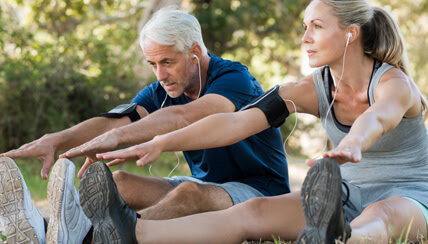Delving Deep to Find Answers Annual Video 2018
Wyatt would stop breathing during exercise, Mary was bullied about her eczema and Patty had a mysterious infection. They all came to National Jewish Health, the place where we slow down and delve deep to find answers. You’ll be moved by these stories and how our physicians think outside-of-the-box to make the right diagnoses and find the right treatments that get our patients back to health.
Transcript
Speaker 1: Yeah. And his rhinitis is starting.
Speaker 2: There we go.
Speaker 3: Look at his eyes.
Jeana: Yep.
Speaker 1: Yeah, he's having trouble breathing, too. It started right after we ran a tiny bit.
Jeana: Here, look at me, Wyatt.
Speaker 4: Yep. Take a moment and relax.
Jeana: Yep. Right there over the back.
Speaker 4: And then you can just go right down there. Right there. It's okay. You got it. Let's do it.
Jeana: Do it. You got it.
Speaker 1: Push and hold.
Speaker 4: Push and hold.
Jeana: Stab yourself with the pen.
Speaker 4: One. Two.
Jeana: The first time Wyatt had an anaphylactic reaction, he was struggling to breath. I remember waiting for the ambulance to come, and I remember just not knowing what to do. Just kind of holding on to his arms and his car seat and just feeling like I was watching him die.
Jeana: It was about sixth grade that he started having reactions after recess at school. He would exercise and all the sudden, he'd get red and itchy and have a lot of trouble breathing.
Wyatt Carrell: It's pretty scary knowing that I could die from my allergic reactions.
Jeana: Thankfully, our doctor here referred us to National Jewish. And it was like a weight had been lifted. But I knew we were going to get our answers. We were going to be able to keep Wyatt safe.
Christina: Mary Elizabeth was struggling with eczema pretty much all her life, but within the last four years has really struggled with it.
Mary Elizabeth: Well, when I first got here, I was very self-conscious of myself. Going into school and everything, I always had on a hoodie and sweatpants to hide my arms and my legs. People would make fun of me at school, because I was different colors and a failing student. And soccer was taken away from me.
Christina: I finally said to her dermatologist, "If this was your daughter, what would you do?" And he said, "I'd go to National Jewish Health."
Samantha Long: We just weren't fitting into the right boxes for treatment, and they sent us here because National Jewish is able to think outside of the box. They're the ones who make the boxes for
everyone else in the country.
Patty V.: Our second granddaughter was due to be born in October, 2014. I was gonna go down and help. And the day that she was due, I started running a high fever. I went to the emergency room, and they put me in the hospital. And my daughter went into labor the same day, in the same hospital. While our granddaughter was being born, I just was overwhelmed with sadness that I couldn't be there. That I couldn't help. But that was just one of the experiences with this disease. You didn't know when it was gonna hit, what was gonna cause it to hit, because you didn't know what was causing it.
Gwen Huitt: Her problem was billed initially as just recurrent lung infection. And once you dug into her case a little further, you realized there was something more that was driving this infection.
Rebecca Keith: Getting at the right approach to treat the inflammation turned out to be quite challenging. Every time we thought we would have things under control, then she'd have another exacerbation. But I don't think giving up was ever an option, because that's just not a choice.
John Jerome: I've felt, frankly, that here, they take a deep breath. They slow down, and they really delve deep.
Elizabeth R.: Being in the lab allows us to ask creative questions, to think outside the box, to push the boundaries of science.
Lee Reinhardt: Great science, to me, means discovering something that's never been seen before, and understanding that in such a way that that discovery can make an impact in somebody's life.
Jordan J.: I wanna stop the immune system from attacking one's own body, in order to help patients with autoimmune diseases.
Moumita Ghosh: I'm working with several doctors. So what our goal, as a scientist, just taking something from bench to bedside and back.
Jennifer Honda: There's no other place in the world where this kind of research can be done. We have the clinical expertise. We have the research expertise. That all sort of comes together to help patients.
Nathan R.: This was Sherlock Holmes, basically. This is someone coming in and really not knowing what the culprit was.
Jeana: It was incredible. Every morning, we'd get together with the doctors and formulate a game plan. We started to think that the food might be working together with the exercise to cause anaphylaxis in Wyatt. So they started feeding Wyatt wheat bread, and then he'd run a mile and a half and shoot baskets. And then we would monitor to see if he had a reaction. He was running with his doctor around. And the mothers are there, and one by one, every lap, these kids start joining in, and are running with Wyatt around this floor. It was this really overwhelming moment for me. We're all there, dealing with these kids that are facing so much. It's this beautiful, fun moment, but at the core of it, I'd look at him and we're all sitting there cheering him on and hoping that
he starts having trouble breathing.
Jeana: Stab yourself with the pen.
Speaker 4: One. Two.
Jeana: This is it.
Speaker 1: [crosstalk 00:05:52] my goodness.
Speaker 4: There you go.
Speaker 1: This is the redness that he usually gets?
Nathan R.: Is this soy?
Speaker 1: Yeah.
Jeana: Yeah.
Nathan R.: He's a great kid, number one. Not all kids are that calm when these things happen. So now we can send him and we can say, “Just stay away from soy before you exercise, and you are gonna be fine.” And that, to him, is a huge, huge deal.
Jeana: It was just the most exciting thing to know that we had figured out what was causing life-threatening reactions in my son for two years.
Christina: National Jewish Health has been life-changing for my daughter.
Mary Elizabeth: I'm ready to come home and see my friends and my family, because they haven't seen me without pain in so long. It's made me such a happier person. I'm just ready to see what's the next step for me in this life.
Patty V.: They kept reassuring me that they would never give up on me. And they didn't. Once they decided it was this panbronchiolitis, they started me on the drug the very next day, and I've been on it for a year.
Rebecca Keith: It took a large, multidisciplinary team working together to really figure out the right medications, airway clearance, to get Patty to a better place.
Gwen Huitt: She hasn't been hospitalized in a year now, which, in the past five years, is a record. I think with cases like Patty, they're perfectly suited for National Jewish. This is what we do. People come here because they're having trouble breathing, or they're having some difficulty that we can help them with. We may not find the answer immediately, but what we do is we keep looking. And we work together to find a solution to a patient's problem. And that's our mission. That's what we do at National Jewish.
Speaker 5: At National Jewish Health, breathing science is life.
Your gift today will support children and adults with lung, heart, immune and related conditions.
Make A Donation TodayRelated Health Insights and News
Want to use this on your website? Fill out the content usage request form and then copy this code: https://youtu.be/q__Sp_2HCW8





